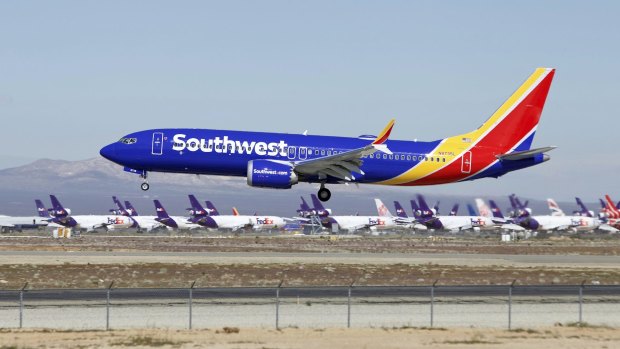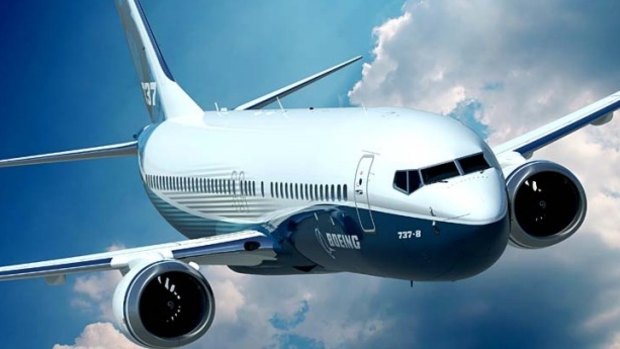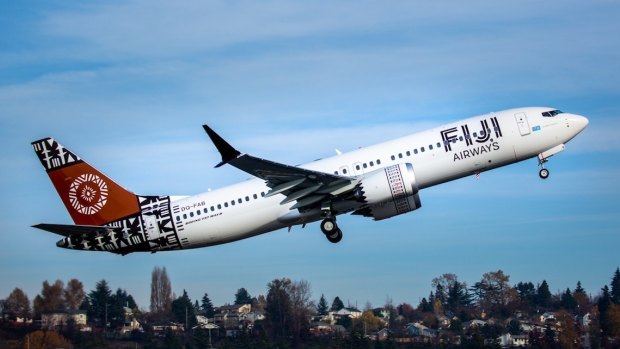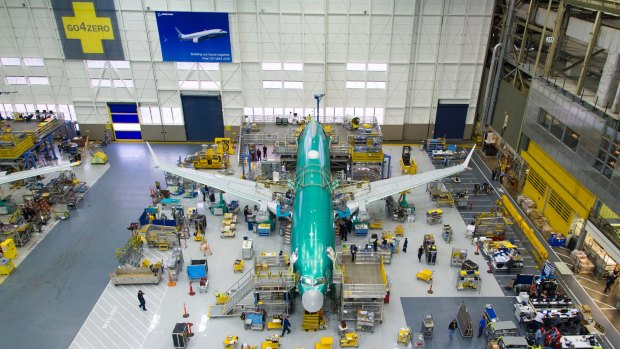This was published 3 years ago
Everything you need to know about the Boeing 737 Max: Is it safe, and which airlines will fly it?
By Oliver Smith

A Southwest Airlines Boeing 737 Max lands at the Southern California Logistics Airport in the high desert town of Victorville.Credit: Matt Hartman/AP
With the Boeing 737 Max returning to the skies in the US, it's only a matter of time before travellers find themselves on board one of the aircraft. All we need is for lockdown to be lifted, countries to remove their travel restrictions, and airlines to offer services that utilise the controversial jets…
OK, so we might be waiting a while.
Nevertheless, the Max is coming to Australian skies, slowly but surely. Here's everything you need to know about it.

The Boeing 737 MAX.
Why is it controversial?
The Max was launched to much fanfare in 2017, and billed as the short-haul plane of the future, but was grounded worldwide in March 2019 after 346 people died in two crashes: Lion Air Flight 610 and Ethiopian Airlines Flight 302. A faulty flight-control system that forced down the nose of the plane was implicated in both crashes.
These problems have now been addressed, the Max has US Federal Aviation Authority approval, and on Tuesday American Airlines relaunched passenger flights using the aircraft with a trip from Miami to New York, the first step in its plans to gradually reintroduce the model.

Fiji Airways became the first carrier in Oceania to operate a 737 MAX when it received its first jet in November 2018.Credit: Craig Larsen/Boeing
So is the jet safe?
That's the opinion of US aviation authorities, and the European Aviation Safety Agency (EASA) is expected to give it the green light in the new year, paving the way for European airlines to start flying the Max.
The process could be slow, however, as all carriers are required to complete fresh pilot training before taking passengers.

The Boeing 737 Max under construction.Credit: Boeing
An incident involving a Max last week further heightened scrutiny around the jet's return, with an Air Canada aircraft on a test flight forced to make an unscheduled landing after suffering engine trouble.
As well as the software changes, Boeing's chief executive, Dave Calhoun, has said the company has improved its safety practices and culture since the fatal crashes.
"We will never forget the lives lost in the two tragic accidents that led to the decision to suspend operations," he said. "These events and the lessons we have learned as a result have reshaped our company and further focused our attention on our core values of safety, quality and integrity."
As things stand, the Max has one of the poorest safety records of any passenger aircraft, ever. Boeing has already delivered 387 Max units and they have already been used on an estimated 650,000 commercial flights since the very first one, a Malindo Air service, took off on May 22, 2017. That's an average of just 3.08 fatal accidents per million flights.
Most people would consider that a very small number, but in the ultra-safe modern age of flying, it isn't. According to Boeing's own statistics, which include all jet services from 1959 to 2017, the rest of the 737 "Next Generation" family has a combined fatal accident rate of just 0.08 per million departures.
For the 777, Boeing's long-haul workhorse, the rate is 0.18. Other popular jets can boast similarly reassuring numbers. The 767? 0.1. The A330? 0.19.
And a clutch of models have a flawless record, including the 747-800, the A350 and the 787 Dreamliner.
In fact, to find a fatal accident rate worse than that of the 737 Max, you'll need to look exclusively at models no longer in production. The figure for the DC-8, not built since 1972 and now little more than a museum piece, is 4. For the 707, out of production for 40 years, it is 4.28.
Concorde sits at the bottom of the table. It was involved in just one fatal crash but only flew 90,000 times – that's 11.36 fatal crashes per million departures.
That accident rate will tumble in the coming months, of course (assuming no further problems are encountered).
Which airlines will fly the Max?
As mentioned above, 387 have already been delivered to airlines around the world, including 24 to American Airlines, 31 to Southwest, 24 to Air Canada and 14 to United.
In Europe, Tui has already been handed 15, Norwegian has 18, Turkish Airlines 12 and Icelandair 3. So those heading to the Turquoise Coast next summer, or the fjords of Norway, may be the first Britons to experience the jet for themselves.
Pretty soon, however, most travellers will get the chance. Boeing has received more than 4,000 orders in total, with Europe's biggest budget airline, Ryanair, expecting a whopping 135 (with an option for a further 75). The first will be delivered in early 2021.
What if I don't want to fly on one?
You won't be alone. A Reuters/Ipsos opinion poll released on Monday suggested that Americans are less familiar with the two fatal Boeing 737 Max crashes than they were last year.
Just 39 per cent of respondents said they were familiar with the two crashes, compared to about 50 per cent in a May 2019 poll.
However, when respondents were told about the aircraft's safety issues, 57 per cent said they were not likely to fly in a Max, while 37 per cent say they would be likely to fly in it once it has been in the air for six months or more.
Some airlines, sensitive to these concerns, have said they will give nervous passengers the chance to fly on a different aircraft if possible.
American Airlines is informing customers that they are choosing to fly on the Max aircraft before they confirm their ticket purchase and the carrier said it would re-book customers who do not feel comfortable onto a different aircraft.
"No one has to go on the Max if they don't want to, but if you want to, it's there," American's Chief Operating Officer David Seymour said at a media event aimed at promoting confidence in the 737 Max earlier this month.
Last month Ryanair boss Michael O'Leary said that worried passengers would be transferred free of charge to another available flight if they turn up at the airport to find they are flying on a Max (now rebranded the 737-8200).
"It's not possible to tell people they are flying on a 737 Max when they book, as we only assign planes to various routes at short notice," said O'Leary, who will be on board the first Ryanair delivery flight from Seattle to Dublin. "If anyone gets in a Max and then wants to offload we will create an opportunity and move them to the next flight. We won't force anybody on."
How do I find out if I'm flying on a Max?
If you can't wait until you spy your jet on the tarmac, or actually board the aircraft and study the safety instructions card, you could check the website FlightRadar24. It shows data from every flight in the world, including the model used, and there's a fair chance your airline will put the same aircraft on the same routes each week. For the last fortnight, BA's daily flight to Bridgetown, Barbados, for example, has used a Boeing 777.
However, as Ryanair's O'Leary makes clear, some airlines (particularly low-cost carriers like the Irish outfit) do tend to chop and change their aircraft, so this system isn't foolproof.
What's so great about the Max anyway?
Of most interest to airlines is the improved fuel efficiency (+14% on previous 737s), but what is there for passengers to get excited about?
Overhead cabins are a little bigger, and "ergonomic slimline seats" promise a smidge of extra legroom, which is always welcome.
A few complaints have been made about the tiny loos, however, with both passengers and crew members (back in 2018) insisting that the sinks were so small you could only wash one hand at a time.
Telegraph writer Annabel Fenwick Elliott was able to fly on one with Icelandair before they were grounded. She said: "[The loos] are certainly not what you'd describe as spacious, but then aircraft loos never are. Were they noticeably more cramped? Not particularly, but it could be that Icelandair has configured slightly larger bathrooms than other airlines.
"But perhaps I couldn't see well enough to fully scrutinize. The bathroom, you see, was flooded with a deep blue light. It's part of Boeing's new Sky Interior cabin design, an LED mood lighting system which changes according to the stage of the flight, and it beats standard plane lighting by a country mile."
She added: "This aircraft was very noticeably quieter than older models (40 per cent quieter, according to Boeing) thanks to new engine technology. Boeing claims, too, to have lower operating costs than its Airbus rival, the A320neo, being 8 per cent cheaper "per seat" to run, apparently. Why do we care? Because in the age of cheap fare wars, these savings could translate to lower ticket prices." Now that's something we can all get excited about.
Which airlines have the 737 Max in their fleet?
Southwest: 31
GECAS (leasing company): 25
American: 24
Air Canada: 24
Norwegian: 18
China Southern: 16
Air China: 16
Air Lease Corporation (leasing company): 15
TUI: 15
Flydubai: 14
Lion Air: 14
United: 14
China Eastern: 14
Turkish: 12
WestJet: 12
Xiamen Air: 10
BOC Aviation (leasing company): 8
SpiceJet: 7
Hainan: 7
Shandong: 7
Gol Transportes Aéreos: 6
Aviation Capital Group (insurance company): 6
Copa: 6
Aeroméxico: 6
Silk Air: 6
A further 22 companies have at least 1 737 Max in their fleet.
Which airlines have the most orders?
Southwest: 280
Flydubai: 251
Lion Air: 251
VietJet: 200
United: 185
Air Lease Corporation: 141
SpiceJet: 136
Ryanair: 135
Jet Airways: 125
GECAS: 103
SMBC Aviation Capital (leasing company): 103
Gol Transportes Aéreos: 101
American: 100
Aviation Capital Group: 100
The Telegraph, London
Sign up for the Traveller newsletter
The latest travel news, tips and inspiration delivered to your inbox. Sign up now.